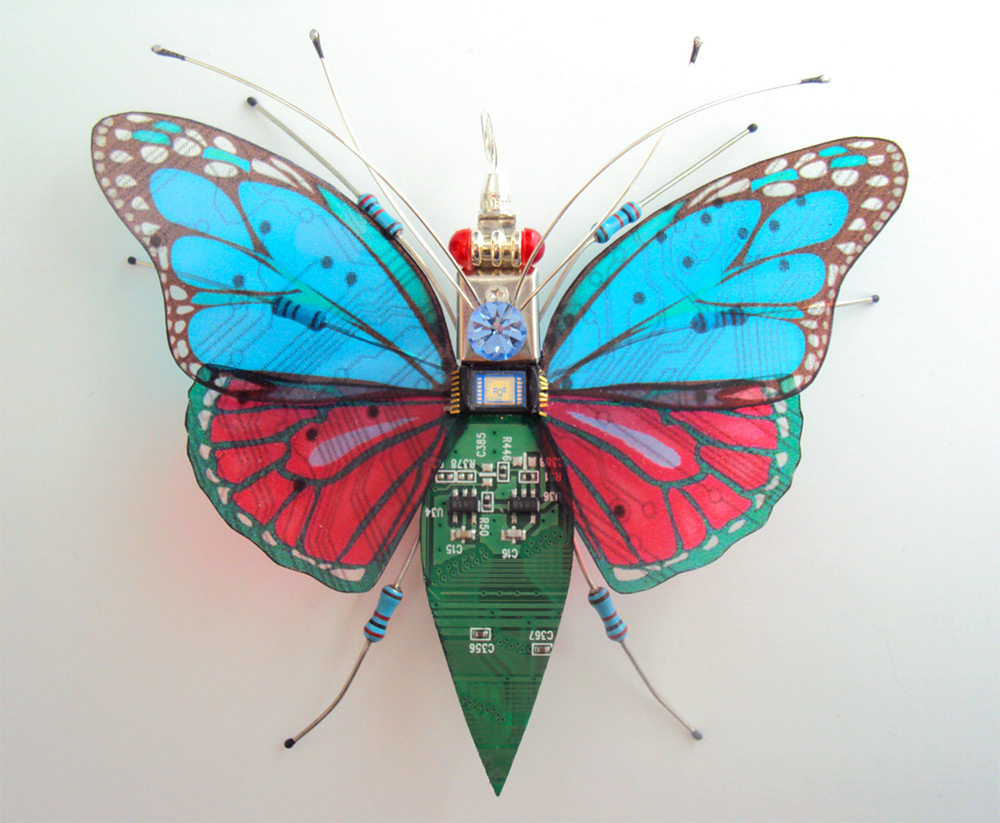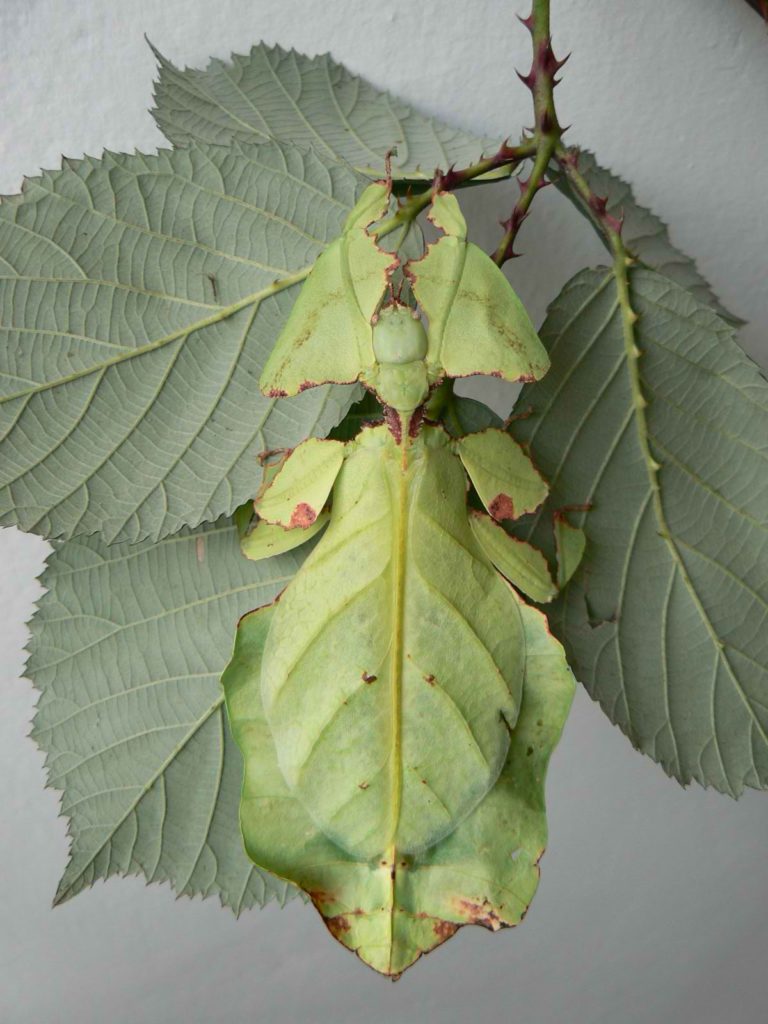Becoming Insect
Contemporary Studio Art,
Social Theory & Swarm Politics
ARTS 388 / Pathways
Queens College CUNY Art Department –
SPRING 2024 – Tuesdays – 1:40-5:30
Klapper Hall Room 284
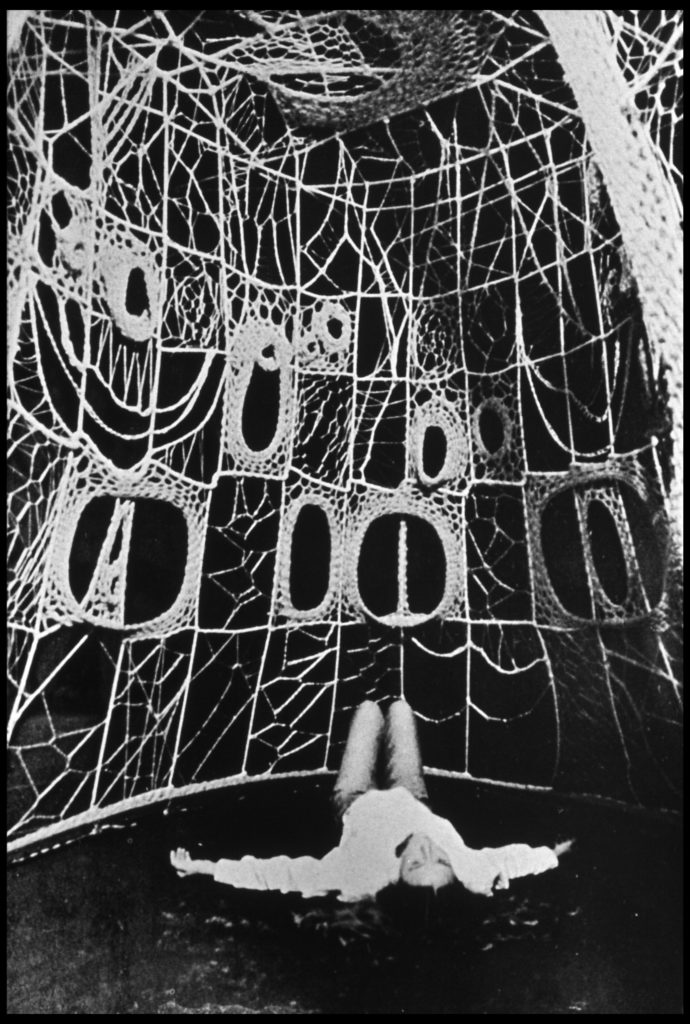
Faith Wilding, Womb Room (1972)
———-
Instructor:
Gregory Sholette
gsholetteSTUDIO@gmail.com
Tuesdays 2:00-5:30
Klapper Hall Room 284
———-
TO VIEW BECOMING INSECT PROJECTS
FROM PAST CLASSES
CLICK HERE
Basic Downloadable Syllabus : Download
Class Description:
This is an experimental interdisciplinary seminar investigating contemporary art, spatial structures, visual communications, literary culture, digital imaging, and the social significance of critical thinking and aesthetic interpretation. A single ant is photographed dragging a hand-cut jewel across a linoleum-tiled floor. The image goes viral on social media networks, but it also tells a powerful visual story about the dramatically different scales, motivations and morphology between insect and human societies. Fusing project-based studio practice with individual research this hybrid seminar explores the shifting line between contemporary art and social practice through the lens of what we consider the human and the non-human. By focusing on the figure of the insect as it appears in art, science, philosophy, and popular culture students will develop collaborative projects that address one or more related topics including animal intelligence, networked technology, cyborg affectivity, and interventionist public art. Among the materials we will cover in class include sculpture by Louise Bourgeois, installations by Damien Hirst, tactical media interventions by Electronic Disturbance Theater, and a number of “giant bug” movies from the 1950s. We will also read selections from the theoretical books including “Insect Media” by Jussi Parikka, watch excerpts from movies such as Them! and Starship Troopers, and listen to the sound of crickets used to defend a virgin forest in California by the Center of Tactical Media.
———-
Requirements:
+ Collaborate with other student researchers in a work group in an ongoing investigation
+ Investigate a specific research topic and use visual art to generate new knowledge on it *
+ Incorporate research and discussion into Final Project
+ Maintain a small notebook/sketchbook and update this “field journal” every week
+ Present your research findings to class for discussion
+ Final Project is to be designed, created, exhibited, or performed and documented
+ Participate in course discussions/demonstrate you’ve done assigned readings, viewings etc…
FEB 6: Research Groups formed and a research topic is selected.FEB 27: First presentation of initial research and ongoing project development (sketches etc…).MARCH 19: Second presentation of far more developed research and projects (things we can see, touch, etc…).May 7 & 14: Final presentations of final projects.
Grade Composition:
+ 25% Attendance and engagement in class discussions
+ 25% Weekly writings in you Field Journal
+ 50% Your final research project and Evaluation Paper
Expectations:
Throughout the course you will be tasked with stretching your imagination and your tacit social interpretation of the world in order to consider the relationship of visual art to such fields as media arts, communication, digital imaging, architecture, urban planning and even issues of social relations and social justice while using the specific characteristics of insects as a material and conceptual vehicle towards creative learning. Through the evaluation and discussion of your projects this heuristic process of self-learning will be brought into the foreground.
PATHWAYS LEARNING OUTCOMES
-
Gather, interpret, and assess information from a variety of sources and points of view.
-
Evaluate evidence and arguments critically or analytically.
-
Produce well-reasoned written or oral arguments using evidence to support conclusions.
-
Identify and apply the fundamental concepts and methods of a discipline or interdisciplinary field exploring creative expression, including, but not limited to, arts, communications, creative writing, media arts, music, and theater.
-
Analyze how arts from diverse cultures of the past serve as a foundation for those of the present and describe the significance of works of art in the societies that created them.
-
Articulate how meaning is created in the arts or communications and how experience is interpreted and conveyed.
* List of Possible Research Topics for this Class:
2024 LIST:
Insects/Light/Clothing
Insects/Music/Culture
Insects/Adaptation/Thinking
Insects and Imitation/Camouflage
Future Bugs!
Older Lists- INSECTS &
- FOOD
- ROBOTICS
- FASHION
- B-MOVIES
- MIMICRY
- SURVIVAL AESTHETICS
- SOUNDS
- SWARMS
- ARCHITECTURE
- ENVIRONMENTAL ISSUES
- COMMUNICATION/ LANGUAGE
- TERMINOLOGY OF COMPUTERS
- PHYSIQUE
- TRANSFORMATION OF HUMAN TO INSECT
- TACTICAL MEDIA
- CRAFTIVISM
- ROBOTICS
- GAMING
Insects Doing Incredible Things – a FB Site
And What Are Your Ideas?
Such as:
6 prompts for Buzzing, Thinking, Flying, Metamorphosing:
If you were an armed jellyfish like this one in the video, what would you defend from whom? How would you think un-humanly? Could you adapt to be a New York City resident? How? Who would be your friends? How would you be treated by other New Yorker’s?
Upside-Down Jellyfish Release Weaponized Goo Packed With Toxic ‘Grenades’
How would you apply the characters and elements in this story to your own life today? Could you act that out? Illustrate it? Make a puppet show about it? Make outfits for people to wear and a script for them to follow based on it?
Metamorphosis by Franz Kafka
What sort of METAMORPHOSIS would you go through to be a better student or parent or citizen or sibling? What would you go through to work with others better? If you were transforming into a protector of the environment, what would you become?
Monarch Butterfly Metamorphosis Time Lapse
Think of a woven art work or piece of clothing or a useful object (a hat or accessory or a bag to hold things) inspired by this animal and its web?
Orb Weaver Spider
How do these recorded insect sounds suggest or describe: Spaces? Behaviors? Languages? Communications? Social exchanges? Happiness? Working Together? Being Angry? Losing your temper? Greeting Friends? Measuring Passing Time? (Could you make an insect clock using sound alone?) Another insect sound resource.
Based on our previous readings what kind of board game (or video game) would you design?
Game: Bugs in the Kitchen
———-
Production Resources on Queens College Campus:
-
MAKER SPACE
-
KLAPPER DIGITAL LAB
-
LYNDA .COM TUTORIALS LOGIN
AND PLEASE SEE SEDIQ’S WEBSITE AT: https://sediqkholdi.com/
———-
ADDITIONAL RESOURCES:
SAL ASARO’s INSECT SCIENCE RESOURCES PAGE
OTHER ART & MEDIA RESOURCES FOR CLASS
HUMAN & INSECT INTERACTION Wikipedia
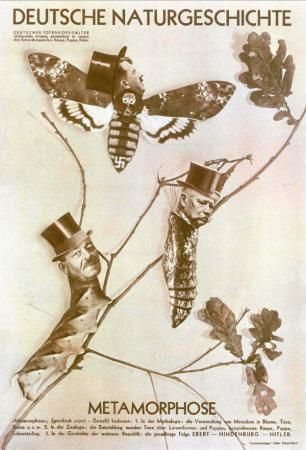
John Heartfield a 1933 photomontage targeting the German Nazi Party’s “evolution.”
———-
THE SYLLABUS
* Changes to class content and readings may take place during the semester: always check online.
* * All readings, viewings and other resources are available at the online syllabus:
———-
Week one: JAN 30: Introductions

Same day workshop: following the professor’s lecture and our discussion of news articles that you bring to class, you will break into an investigative team to explore and imagine what kind of spaces an insect or other arthropod would want to inhabit within Klapper Hall. Your will use your weekly field journal to take notes, create sketches, make measurements of the light and space, the exits and entrances and hiding space potential of the room or space that you are observing. And should you encounter an insect or other arthropod consider also taking a photo of it, or if dead, bring it back to the classroom and we will collectively investigate the physiological qualities and taxonomy as part of your first field journal entry that you will continue to update throughout the semester.
An initial reading: CULTURAL ENTOMOLOGY by Ayla Tüzün
Week two: FEB 6: Create Groups
& Chose Research Topics
Task 1: Establish working groups and research topics (6 with 3 members each)
Task 2: Your Research Group will decide on one area of focus and one insect type.
For example:
Architecture and Bees or
Robotics and Dragonflies or
Needlework/Weaving and Spiders or
Mantid Insects and Camouflage or
Wearable Art and Beetles or
Social Cooperation and Ants or
Sound Communication and Night Insects
As. you can see, these combinations can go on and on!
Research Groups will explore their selected topic for the rest of the semester, and each of you will produce a work related to the Research Group you are part of (collaborative projects are also a possibility).
And once again:
FEB 6: Research Groups formed and a research topic is selected.
VISITS: Linda Jackson KLAPPER DIGITAL LAB/ Nick Normal MAKER SPACE/ Alex Wong
———-
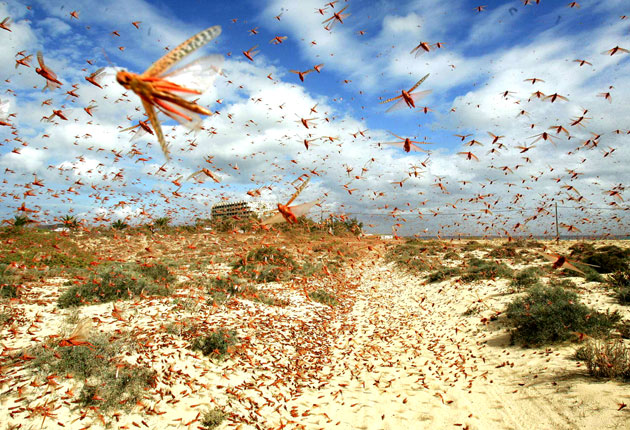
All images & links on this page are strictly for educational and non-commercial use.
Contact professor Sholette if you wish to discuss: gsholetteSTUDIO@gmail.com
Week three: FEB 13: Insect Media & Swarms
Task: After Presentation & discussion: Break into working groups / Report on Brainstorming end of class
INSECT MEDIA: According to Professor Jussi Parikka the figure of the insect as a metaphor and image has shifted over the centuries and now stand for some of the most advanced and experimental aspects of new media art and technology. The introduction to his book Insect Media explores this thesis in which he insists the new network culture is “a rather peculiar phase in our modern technical civilization, as it seems to be a combination of high technology and a fascination with such seemingly simple life forms as insects. We continuously make sense of emerging media and technology through references and metaphors borrowed from the biological world: viruses, worms, swarms, and other similar eclectic ideas that suggest a complex view of scientific culture.”
SWARMS: A multitude of frustrated youthful citizens swarmed into Tahrir Square in Egypt in 2011, forming a “hive-like” mass that directed traffic, swept and cleaned streets, and eventually brought down the country’s powerful dictator Hosni Mubarak. All of this was accomplished without definitive leaders, organizational hierarchies, or ideological positions. Several months later a similarly leaderless swarm took the form of marauding locusts in London, gleaning and carrying off goods and property denied them in day-to-day life. Meanwhile, in the virtual world of the Internet, another leaderless collective known as Anonymous hacks into the data streams of authorities and corporations sometimes just for fun, and sometimes to make a political statement as when they cyber-punished PayPal and Mastercard for withdrawing the account of WikiLeaks. How does this collective swarming operate when it not only eschews ideological positions, but also rejects centralized leadership? Is the group “consciousness” of social insects -ant, wasp, and bees- one possible metaphor for this new, leaderless collectivism? Does the hive body represent the future of the social imagination for nations, networks, and humanity?
Readings and resources:
- Excerpts from book Insect Media
- PDF of : Insect Media Jussi Parikka
- Lauren Wilcox, “Drones, Swarms and becoming-insect: feminist utopias and posthuman politics.”
- Brian Holmes, “Swarm Machine.”
- Insect swarming inspires jazz software
- Karin Wetzel — Swarming (music)
- Village of the Damned (film trailer 1963)
- Esther sent this video: Swarm of 750,000 bats in Austin, Texas
Week Four: FEB 20:
continue working on projects
special presentation on Black Fantastic exhibition Hayward Gallery London
Task: Continue to research, read and communicate with your research group remotely & please review the following topics:
Insect Weavers
Despite a pervasive cyber-aesthetic a recent wave of younger craft-based artists have revived needlecraft as a vital form of artistic practice, sometimes combined with public art, and/or social activism. This so-called “yarn bombing,” and “craftavism” has not so much rejected the dominant digital paradigm as it has made use of the networking power of the Internet to generate widespread knitting circles made up of individuals who will likely never meet in person. Sharing and transmitting information about wool and patterns actually makes perfect sense if we reflect on the very moniker: the World Wide Web. At the same time, the production of woven materials and crafted objects has played a central role in human civilization including classical myth: think of Penelope’s making and unmaking of the tapestry in the Odyssey, or the golden thread Ariadne weaves through the Minotaur’s labyrinth.
Actual weaving activities carried out by animals have inspired scientists and philosophers. Spider silk is being genetically engineered within goats to produce a super-strong, yet flexible filament; the feminist artist Faith Wilding created an influential web installation at Women House in the late 1970s; and Karl Marx famously made reference to both the architecture of bee colonies and the natural labor of the silkworm in his 19th Century analysis of Capitalism.
Reading: Forward to FASHION-able (review examples up to page 56)
Additional Media & Readings:
From Esther Berry:
“The art of weaving is a profound metaphor for understanding the workings of the universe and our place in it. Through the physical process of weaving, we gain a better understanding of this world and how we as human beings are woven into it.
We are bound to our bodies with the fragile threads of earth. Our skeleton is a loom on which every system is strung and woven with our blood. The meeting of opposite elements woven into a whole is the quest of every spiritual seeker. No wonder the art of weaving is so appealing: it is the c of creating the unified one out of two opposites.”
http://www.weavingalife.com/about/weaving/#.XkthzC2ZPyU
Faith Wilding: UnNatural Parables
Faith Wilding, Arlene Raven: Womanhouse
Gestures of Resistance: Cat Mazza
Faith Wilding: Monstrous Domesticity
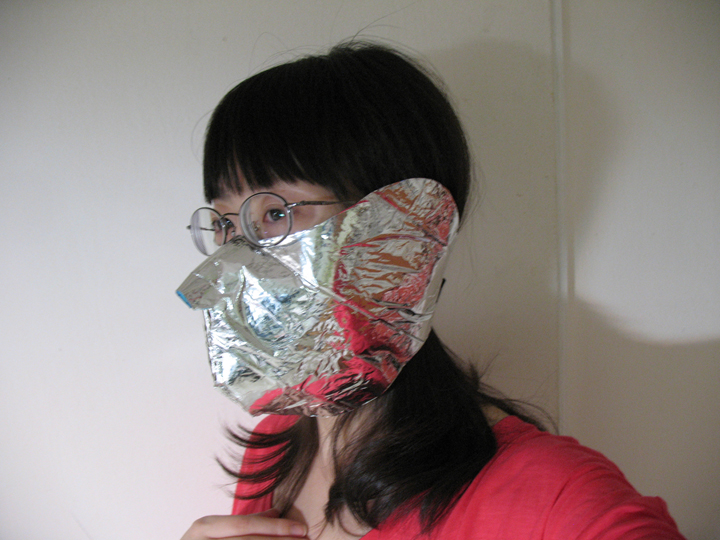
Insect Warriors
Nomadic raiding colonies of Army Ants and Marauder Ants (Pheidologeton) sweep over their pray, sometimes tactically stationing soldiers along pathways to protect their mass movement. Robotic drones developed for the United States war on terror locate and destroy human targets In Afghanistan. And military planners study the swarming behavior of social insects in order to rethink the tactics of war.
Readings and resources:
Additional Optional Reading:
And march over to these sites for more action:
- http://www.darpa.mil
- BBC NEWS: Pentagon plans cyber-insect army
- Hacking a remote-controlled moth with insect venom
——————————–
Week Five: FEB 27: Warriors…
Task 1: Review material from previous two weeks and update group research
Task 2: After presentation: Break-out into working groups / End of Day: report on group research project methodology up to this point
We will also continue our discussion with a focus on robotics and the way DARPA (Defense Advanced Research Project Agency) is using insects as potential weapons of war.
Resources:
Newsweek: DARPA Is Making Insects That Can Deliver Bioweapons, Scientists Claim
Readings and resources:
-
DARPA (The Defense Advanced Research Projects Agency) -
Controllable Cyborg Beetle -
Robotic Starfish Killer -
Microbot Microbes
Week Six: MARCH 5:
Phasmids and Mimics
Task: After presentation: Break-out into working groups
Camouflage, mimicry, the radical morphing and adaptation to one’s external environment, these are the tactics of survival in a hostile world. As theorist Michel De Certeau once argued everyday resistance to oppression requires a tool box of primordial “simulations, tricks, and disguises” that are not unlike certain fishes or plants. He could have added that this cryptic “art of the weak” is also the empire of the insect, in particular the Phasmida order that includes stick insects some that physically resemble flowers, vegetation, and even inert materials. But what if being an artist also requires an act of trickery and disguise? Have artists and informal art collectives incorporated insect-like mimicry as a form of survival?
-
Mimicry and Legendary Psychasthenia Roger Caillois
-
Esther Berry’s powerpoint:
-
MAMAN by artist Louise Bourgeois
—————————————————————–
Week Seven: MARCH 12 Architects
Task: After presentation: Break-out into working groups
From termite mounds to Paper Wasp nests to Caddisfly larva’s portable homes made of stones and sticks found on river bottoms, insects are formidable constructors and makers. We will look at some of these remarkable fabrications and discuss ways their forms might become part of our human world in imaginative ways. Please review the following projects and ideas and find at least one example related to insect architecture to share with the class this week online:
Robots Weaving Insect-Web Architecture
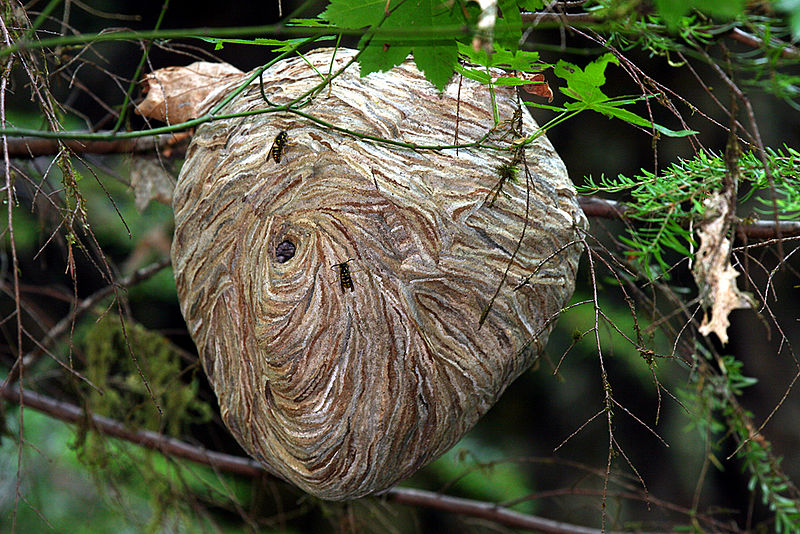
Week Eight: MARCH 19: Bug Movies
Week Nine: MARCH 26
Task: After presentation: Break-out into working groups
We will look at excerpts from a number of movies featuring insects as monsters or as something else strange and challenging in order to understand what social figure bugs play within the popular cultural imagination.
WEEK TEN APRIL 2: An Insect’s Point of View
Task: After presentation: Break-out into working groups
- Jeff Goldblum’s monologue in David Cronenberg’s movie remake of “The Fly” asks have you ever heard of insect politics CLICK
- But what does being an insect really feel like? Scientist Jakob Johann Von Uexküll famously tried to describe what he called the signifying experience of a tick using his concept of the umwelt.
- Tick’s Eye View: A Stroll Through the World’s of Animals and Men
WEEK ELEVEN: APRIL 9
Pre-Completed Projects
Today’s class is run by research individuals/groups.
Readings and resources folder: To be selected by students for final projects.
WEEK THIRTEENTH: APRIL 16
Visit with Dr. Jessica Ware at AMNH
Dr. Jessica L. Ware
Associate Curator of Invertebrate Zoology
American Museum of Natural History
+++++++++++++++++++++++++++++++++++++++++++
+++++++++++++++++++++++++++++++++++++++++++
SPRING BREAK
SPRING BREAK
SPRING BREAK
+++++++++++++++++++++++++++++++++++++++++++
+++++++++++++++++++++++++++++++++++++++++++
WEEK FOURTEENTH APRIL
30: Research Seminar TBA
Today’s class is run by research individuals/groups.
WEEK FIFTEEN: MAY 7 & 14:
Final Projects REVIEW
Task: Wrap-Up, View all
projects, Note/Sketchbooks
Resources and Possible Research Topics:
News Article Links From Previous Student Researchers:
From Jean Wu: NYT – The Killer Neural Wiring That Links Eyes and Wings in 2 Predators
Remezcla – Monarch Heros Dead in Mexico
Bumblebees’ decline points to mass extinction
Jason: Trees Talking to One Another
Jean: Wings and Eyes Dragonflies
Asaria: Barnaby Dixon’s Puppets
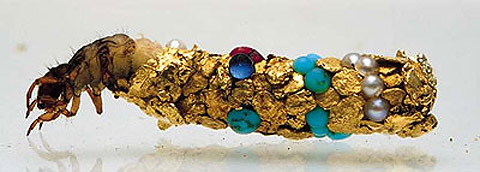
Insects & Art:
Hubert Duprat’s collaboration with Caddisfly Larvae
Rock, Mosquito and Hummingbird project by David Brooks
Nicolas Lampert Insect Machines
Mark Dion’s Systema Metropolis
Gallery: Dead bees become art to highlight colony decline
Maria Fernanda Cardoso Flea Circus
Cloaca apparatus that digests and shits at MoMA
James and the Giant Peach (1996 film)

Audio:
An audio “find” Esther Berry: Albro T. Gaul: Sounds of Insects circa 1960
Timo Khalen: SWARM audio installation
http://www.timo-kahlen.de/soundsc2.htm
http://www.naturesongs.com/insects.html
Museums
THE MUSEUM of JURASSIC TECHNOLOGY
NC State University Insect Museum
Insectropolis: The Bugseum of New Jersey
Tactical Media (Yes Men SurvivaBall)
Insect Sex:
Green Porno with Isabella Rossellini
Insects and Death:
Bees could teach humans a thing or two about social distancing
Literature:
Franz Kafka The Metamorphosis
Lauren Wilcox: Drones, swarms and becoming-insect: feminist utopias and posthuman politics
Art for Animals by Matthew Fuller
“These Butterflies Evolved to Eat Poison. How Could That Have Happened?”
Euology (Animal Collectivism) Wikipedia
A Cooperative Animal Tom Finkelpearl (unpublished text)
Naked Mole-Rats or How I Learned to Stop Reproducing and Love the Queen
Dreaming Invertebrates: Octopus Color Change while Sleeping
Bee genes are responsible for in-hive hierarchy
DARPA (The Defense Advanced Research Projects Agency)
“B” Bug Movies:
Starship Troopers https://www.youtube.com/watch?v=zPYuV_jGk7M
THEM!: http://www.youtube.com/watch?v=qcV78KE38J4
Duke Riley’s Non-Essential Consultants Inc.: https://www.snark.art/non-essential-consultants
Deadly Mantis: http://www.youtube.com/watch?v=bKW39MUQhKE
Wasp Women: http://www.youtube.com/watch?v=E5zAPCwCh40
Beginning of the End : http://www.youtube.com/watch?v=uqVL8blr-rw
The Black Scorpion: http://www.youtube.com/watch?v=vfKakOgshxw
Tarantula: http://www.youtube.com/watch?v=dKGcgDo_ojI
Arachnophobia: https://www.youtube.com/watch?v=4aQ6vg3JB2U
Other Resources
Insect Camouflage: http://www.cals.ncsu.edu/course/ent425/tutorial/Ecology/camo/index.htm
Bioluminescence: How and why do fireflies light up?
iPhone fireflies: http://www.youtube.com/watch?v=EI7yQnRy7QQ&feature=player_embedded
John Heartfield Photoshop Metamorphosis mash-up: http://www.youtube.com/watch?v=qSWRJLFbrPY
Stan Brackhage MothLight 16 mm Film: http://www.youtube.com/watch?v=XaGh0D2NXCA
Edward O. Wilson on Insect Societies http://www.npr.org/templates/story/story.php?storyId=97848794
A Brief History of the Superorganism: https://www.wired.com/2007/07/a-brief-history-3/
Nature: The Gathering Swarms PBS Documentary
Recommended Books:
Insect Media. An Archaeology of Animals and Technology. Jussi Parikka.
The Dada Cyborg: Visions of the New Human in Weimar Berlin. Matthew Biro
The Animal That Therefore I Am (Perspectives in Continental Philosophy). Jacques Derrida
Animal Capital: Rendering Life in Biopolitical Times (Posthumanities). Nicole Shukin
The Affect Theory Reader. Melissa Gregg.
Vibrant Matter: A Political Ecology of Things. Jane Bennett
Guerrilla Metaphysics: Phenomenology and the Carpentry of Things. Graham Harman;
The Ignorant Schoolmaster: Five Lessons in Intellectual Emancipation. Jacques Rancie

